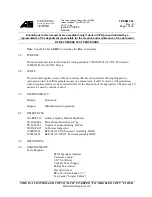
Analog electronic modules
15.8 Overview of parameters of the analog electronic modules
ET 200pro distributed I/O system
Operating Instructions, 03/2013, A5E00335544-08
427
15.8
Overview of parameters of the analog electronic modules
Group diagnostics
You can generally enable/disable the module's diagnostic function by setting this parameter.
Process interrupt (limit value interrupt)
If this parameter is enabled, the system generates a process interrupt when the measured
value
●
overshoots the high limit (see High limit parameter),
●
undershoots the low limit (see the Low limit parameter).
Interference frequency suppression
With this parameter you set the integration time of the module based on the selected
interference frequency. Select the frequency of the applied supply voltage.
Measurement type/output type
With this parameter you set the measurement type/output type, e.g. voltage. For any unused
channels, select the disabled setting. The conversion and integration time of the disabled
channel is "0" and the cycle time is reduced.
Measuring range/output range
With this parameter you set the range of the selected type of measurement, or the output
range of the selected type of output.
Temperature coefficient
The correction factor for the temperature coefficient (α value) indicates by what extent the
resistance of specific material changes relatively if the temperature increases from 0 °C to
100 °C.
The α values correspond to the standards EN 60751, GOST 6651, JIS C 1604, and
ASTM E-1137.
The temperature coefficient is dependent on the chemical composition of the material. In
Europe only one value is used per sensor type (preset value).
The other α values allow a corresponding adjustment to the sensor type used.
















































